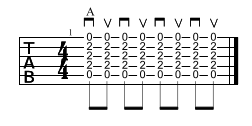Music theory is important no matter which instrument you want to play. It is the back bone of the language of music. We use the piano to show theory, as it is the most visual instrument, but know that it is the same for every instrument.
Notes
The basics of music starts with the natural notes: A, B, C, D, E, F, G
If this seems easy, then try saying those letters without looking at them, but in the reverse order. It seems a silly thing to do, but it ends up being very useful, because when you play music, you will play those notes going up and down all the time. So, below is a keyboard to show you the notes and the distance between the notes. Notice that there are black keys between all the notes, except for B - C and E - F.
Piano Diagram #1
The next thing to know is what sharps (#) and Flats (b) are; to understand that you need to know what half tones are. Half tones are the distance between any key to the next, so from a white key to a black key, or a black key to a white key, or two white keys next to the other, but without a black key in between. The distance of two half tones together are called a tone or full tone or whole tone.
Now, a sharp (#)is when you take a natural note, like C, and go half a tone higher, it becomes C#. If you take the same note and go half a tone lower it becomes Cb. So, every black key can be called by two different names depending on the situation.
Piano Diagram #2
Rhythm
The most important thing in music is rhythm. Even though most people will focus more on the notes that they are playing, if you don't have rhythm, you don't have a song and you can't play with anyone.
First thing to know is the name and value of each note and rest, because for each note there is a rest of equal value.
Notes Pyramid
Rests Pyramid
You may have noticed that each note has a fraction written in brackets next to its name. It is simply because each note has a value relative to the other ones. So, depending on the time signature, notes will have a different value. A time signature is what tells you at the beginning of a music sheet what kind of rhythm the song will have. The example on the right shows a measure that has four quarter notes and the example below shows a measure with six eighth notes.
Measure #2
Measure #1
If you have any questions, you can contact us at patrice@paliatsky.com

























